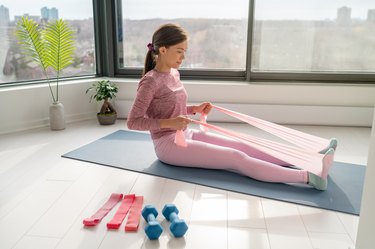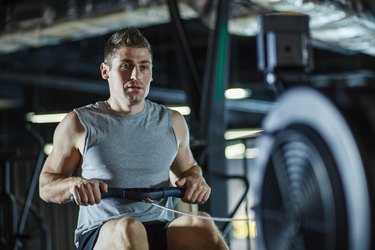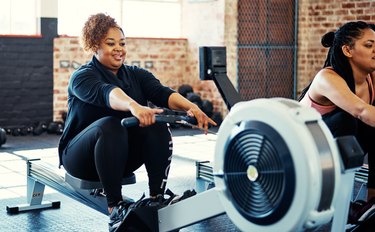
Is rowing a good workout? In a word: yes. There's a reason why rowing crews — teams in long, speedy racing shells with a coxswain barking orders at them from a seat in the back — are so fit. Rowing provides a full-body workout along with many other benefits for your heart, lungs and overall health.
You can enjoy the same benefits of rowing by working out on a stationary rower at the gym. Or if you fall in love with this challenging workout, you can even buy your own rowing exercise machine to use at home.
Video of the Day
Video of the Day
What Are the Benefits of a Rowing Machine?
If you're wondering what does a rowing machine does for your body and mind, read on to learn all the reasons why you should make rowing a regular part of your workout routine.
1. Rowing Burns Calories
If your fitness goals include losing weight, improving power, building strength or boosting endurance, rowing is one of the best ways to do this. One of the top benefits of rowing is caloric burn.
Exact energy expenditure varies according to a few different factors, including body composition, overall body weight and how hard you're working out. But even though it's difficult to pin down a precise number outside of a clinical environment, calorie burn estimates from Harvard Health Publishing give you a great place to start:
- If you weigh 155 pounds, you can burn 260 calories in 30 minutes of moderate-intensity stationary rowing.
- Bump that up to vigorous intensity and you'll burn about 216 calories in 30 minutes.
- If you weigh 185 pounds, those numbers jump to 311 calories for a moderate workout.
- And you'll burn 377 calories for an intense one.
Tip
Not sure if your workout qualifies as moderate or vigorous? If you rate your exertion on a scale of 0 to 10 — where 0 is rest and 10 is all-out effort — moderate activity usually falls around a 5 or 6, while vigorous exertion is usually around a 7 or 8.
As you get more fit, you'll be able to work harder on your rowing machine before you hit that level of perceived exertion.
2. It's a Full-Body, Low-Impact Workout
Not many stationary exercise machines provide you with an upper-body workout as well as a lower-body workout. But when you sit down at the rowing machine, the muscles worked primarily include your chest, back, shoulders, arms, core, quads, hamstrings, glutes and even a bit of help from your calves as you push away from the platform.
The fact that your feet never leave that platform is a bonus too: Because you're not bouncing or jumping, rowing is considered a low-impact workout, which makes it gentler on people whose joint, bone or muscular health keeps them from doing high-impact workouts like running.
3. Rowing Improves Your Heart and Lung Health
If you're wondering, "Is rowing good cardio?" you're in luck. Because rowing gets your body's large muscle groups moving repetitively for an extended period, it qualifies as a cardiovascular workout or, if you prefer, an aerobic workout.
Rowing improves the efficiency of your heart, blood vessels and lungs. which makes your body much more efficient when transporting nutrients and oxygen to your organs.
This type of exercise helps boost your immune system, improve your cholesterol and reduce your risk of many chronic health conditions, including obesity, heart disease, high blood pressure, type 2 diabetes, metabolic syndrome and stroke, according to the Mayo Clinic.
If you already have a chronic health condition, an aerobic workout like using a stationary rower can help you keep some of the symptoms in check. But if you're under a doctor's care, you should always let them know before you begin a new exercise program.
Aerobic exercise has also been shown to boost your mood, and the increase in strength, endurance and overall fitness that cardio provides can help you stay independent and enjoy a better quality of life as you get older.
4. It Provides a Meditative Workout
Although there's a lot of science to back the health benefits of a rowing machine workout, there are also some real-world (if somewhat less-scientific) benefits to this exercise machine.
If you manage to find yourself "in the zone," the repetitive whir or swish of the resistance mechanism (which may be fan blades using air as resistance or water-filled capsules that offer resistance) can verge on a calming, meditative experience — a nice counterbalance to the burn in your thighs, shoulders and back as you power through the workout.
Additionally, rowing emphasizes the connection between your body and breath, which requires focus and concentration. This mind-body connection can reduce anxiety.
5. People of Many Fitness and Ability Levels Can Row
While you may not be able to row super fast in the beginning, those who are new to exercise can hop on a rowing machine for their workout once they learn proper rowing form. (More on how exactly to use one below.)
What's more, rowing machines have been considered safe for people who are visually impaired to use, according to a small August 2015 study in Annals of Rehabilitation Medicine.
6. It's Ideal for At-Home Cardio Workouts
If you live in an upstairs apartment or condo, having a rowing machine means you can exercise quietly and don't have to worry about your downstairs neighbors complaining about the noise of you jumping or running around overhead.
Many home-use rowing machines are also built to fold for storage under your bed or in a closet, so they won't take up too much space. And because they're easy to move around, you can position your rower in front of the television while you watch favorite shows, pivot it to look out the window or use a rowing machine with games as you work out.
What Are the Disadvantages of a Rowing Machine?
Rowing relies heavily on full-body movement. If you can't use both your arms and legs, plus your core, you may need special adaptations to get into and use a rowing machine.
This form of cardio also requires quite a bit of coordination. There's a lot more to proper rowing technique than scooting back and forth and yanking at the handle. If you're not willing to put the time into learning and practicing proper technique (see below for more), you might want to try a simpler piece of workout equipment like a stationary bike.
Tip
A few exercises to strengthen your upper body — and get the hang of the rowing movement — include dumbbell rows, resistance band rows and cable machine rows.
How to Use a Rowing Machine Properly
Although working out on a rowing machine is a great workout, you'll only enjoy its many benefits if you use the proper form. There's a tendency for people who aren't familiar with rowing to simply scoot the seat back and forth, tugging on the handle every once in a while, but there's a lot more to proper rowing form than that.
Because rowing can be such an intense workout, using proper technique is vitally important to both avoiding injury and getting the most out of your workout. It's worth investing a little time in mastering proper form. Concept2, one of the most well-known rowing machine manufacturers, offers an excellent instructional video that breaks down proper form.
It helps to divide the rowing motion into three parts: catch, drive and recovery:
- Catch: Bend your knees as the seat slides toward the front of the machine. Let your arms straighten and hinge gently forward from the hips until — if flexibility allows — your elbows are past your knees. Don't hunch your shoulders forward or push yourself into an uncomfortable stretch.
- Drive: Push the seat back with your legs. As your legs straighten, let your torso hinge slightly back from the hips (as if it were pointing to 11 o'clock on a clock face), then bring your hands in close to your chest.
- Finish: This is the resting position opposite the catch position. Your legs are stretched, your shoulders and back leaning away from your legs and your hands are pulled at the chest.
- Recovery: Perform those movements in reverse: First, let your arms extend, then hinge your torso slightly forward from the hips (to about 1 o'clock on a clock face) and finally, allow your legs to bend as you slide forward to the front of the machine.
Tip
When you're first starting out, having a mirror nearby can provide useful feedback on your technique. But hands-on help from a trainer is even better, so don't be shy about investing in a session or two to get some in-person help and fine-tune your rowing technique.
- Harvard Health Publishing: "Calories Burned in 30 Minutes for People of Three Different Weights"
- ExRX.net: "Row Ergometer"
- Mayo Clinic: "Aerobic Exercise: Top 10 Reasons to Get Physical"
- YouTube: "Concept2 Technique Video"
- Annals of Rehabilitation Medicine: "Effects of Indoor Rowing Exercise on the Body Composition and the Scoliosis of Visually Impaired People: A Preliminary Study"


